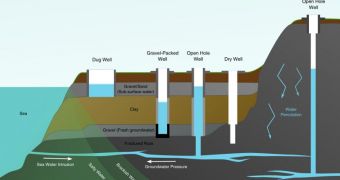Geologists at the United States Geological Survey (USGS) recently published the conclusions of a new report they conducted on the conditions that favored the contamination of public well systems in the nation. More than 100 million Americans receive their daily water from such sources, but all of them are prone to a greater or a lesser extent to being infiltrated by a variety of natural and artificial chemicals. The USGS report quantifies the risk associated with these sources, and identifies the main factors that contribute to water contamination.
One of the conclusions the team insists on is the fact that people need to realize not all wells are subjected to the same risk level. The three main factors that dictate exactly how imperiled a well is of being overrun with toxic compounds are the general chemistry of the aquifer that produces the water, the age of the groundwater, and the number and orientation of direct paths within aquifer systems that allow water and contaminants to reach a well.
Depending on this, water extracted from these sources might have traces of dangerous and naturally occurring chemical elements such as radon, uranium, arsenic, as well as concentrations of man-made compounds, such as fertilizers, septic-tank leachate, solvents and gasoline hydrocarbons, the study found. The investigation was conducted on public well systems in four American states – California, Connecticut, Nebraska and Florida. Natural geology, aquifer condition, human use of the land, and proximity to urban developments were found to be among the main factors influencing the quality of water within the respective aquifers.
“Our findings can help public-supply well managers protect drinking water sources by prioritizing their monitoring programs and improving decisions related to land use planning, well modifications or changes in pumping scenarios that might help to reduce movement of contaminants to wells,” the leader of the USGS groundwater study, Sandra Eberts, explains. She reveals that the investigation began as early as 2001, while the agency has been keeping track of artificial chemicals that make their way into aquifers since 19 years ago.

 14 DAY TRIAL //
14 DAY TRIAL //